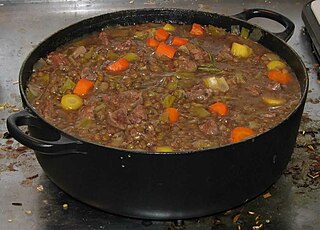
Turkish cuisine is the cuisine of Turkey and the Turkish diaspora. It is largely the heritage of Ottoman cuisine, which can be described as a fusion of Mediterranean, Balkan, Middle Eastern, Central Asian and Eastern European cuisines. Turkish cuisine has in turn influenced those and other neighbouring cuisines, including those of Southeast Europe (Balkans), Central Europe, and Western Europe. The Ottomans fused various culinary traditions of their realm taking influences from Mesopotamian cuisine, Arab cuisine, Persian cuisine, Armenian cuisine, Greek cuisine, Levantine cuisine, Egyptian cuisine, Balkan cuisine, along with traditional Turkic elements from Central Asia, creating a vast array of specialities. Turkish cuisine also includes dishes invented in the Ottoman palace kitchen.

Tripe is a type of edible lining from the stomachs of various farm animals. Most tripe is from cattle, pigs and sheep.

The milanesa is a variation of the Lombard veal Milanese, or the Austrian Wiener Schnitzel, where generic types of breaded cutlet preparations are known as a milanesa.

Peasant foods are dishes eaten by peasants, made from accessible and inexpensive ingredients.

Mediterranean cuisine is the food and methods of preparation used by the people of the Mediterranean Basin. The idea of a Mediterranean cuisine originates with the cookery writer Elizabeth David's book, A Book of Mediterranean Food (1950) and was amplified by other writers working in English.

Fasolada or fasoulada is a Greek, Mediterranean, and Cypriot soup of dry white beans, olive oil, and vegetables. It is sometimes called the "national food of the Greeks".

Iraqi cuisine is a Middle Eastern cuisine that has its origins in the ancient Near East culture of the fertile crescent. Tablets found in ancient ruins in Iraq show recipes prepared in the temples during religious festivals—the first cookbooks in the world. Ancient Mesopotamia was home to a sophisticated and highly advanced civilization, in all fields of knowledge, including the culinary arts.

Levantine cuisine is the traditional cuisine of the Levant, in the sense of the rough area of former Ottoman Syria. The cuisine has similarities with Egyptian cuisine, North African cuisine and Ottoman cuisine. It is particularly known for its meze spreads of hot and cold dishes, most notably among them ful medames, hummus, tabbouleh and baba ghanoush, accompanied by bread.

Assyrian cuisine is the cuisine of the indigenous ethnic Assyrian people, Eastern Aramaic-speaking Syriac Christians of Iraq, northeastern Syria, northwestern Iran and southeastern Turkey. Assyrian cuisine is primarily identical to Iraqi/Mesopotamian cuisine, as well as being very similar to other Middle Eastern and Caucasian cuisines, as well as Greek cuisine, Levantine cuisine, Turkish cuisine, Iranian cuisine, Palestinian cuisine, and Armenian cuisine, with most dishes being similar to the cuisines of the area in which those Assyrians live/originate from. It is rich in grains such as barley, meat, tomato, herbs, spices, cheese, and potato as well as herbs, fermented dairy products, and pickles.

Ghanaian cuisines refer to the meals of the Ghanaian people. The main dishes of Ghana are organized around starchy staple foods, which goes with either sauce or soup accompanied with a source of protein. The main ingredients for the vast majority of soups and stews are; tomatoes, hot peppers and onions. Most Ghanaian soups and stews are red or orange in appearance as a result of the main ingredients used.

Pilaki is a style of Turkish meze and may refer to several dishes that are cooked in a sauce made out of onion, garlic, carrot, potato, tomato or tomato paste, sugar, and olive oil. Beans prepared in this style are served cold, garnished with parsley and slices of lemon. Fish pilaki is also a popular recipe. In Greek cuisine, this style is known as plaki. In Bulgarian cuisine the name is "plakiya".

Afghan cuisine is influenced to a certain extent by Persian, Central Asian and Indian cuisines due to Afghanistan's close proximity and cultural ties. The cuisine is halal and mainly based on mutton, beef, poultry and fish with rice and Afghan bread. Accompanying these are common vegetables and dairy products, such as milk, yogurt, whey, etc., and fresh and dried fruits such as apples, apricots, grapes, bananas, oranges, plums, pomegranates, sweet melons, raisins, etc. The diet of most Afghans revolves around rice-based dishes, while various forms of naan is consumed with most meals. Tea is generally consumed daily in large quantities, and is a major part of hospitality. The culinary specialties reflect the nation's ethnic and geographic diversity. The national dish of Afghanistan is Qabili Palau, a rice dish cooked with raisins, carrots, nuts, and lamb or beef.

Yakhni, yahni (Turkish), or yahniya is a class of dishes traditionally prepared in a vast area encompassing South Asia, the Middle East and Southeast Europe or the Balkans.

Nigerian cuisine consists of dishes or food items from the hundreds of Native African ethnic groups that comprise Nigeria. Like other West African cuisines, it uses spices and herbs with palm or groundnut oil to create deeply flavored sauces and soups.

Angolan cuisine has many dishes popular among nationals and foreigners, including funge, mufete, calulu, moamba de galinha, moamba de ginguba, kissaca, and mukua sorbet.

Gambian cuisine is part of West African cuisine and includes the culinary practices and traditions of the nation of The Gambia. Common ingredients include fish, rice, peanuts, tomato, black-eyed peas, lemon, cassava, cabbage, salt, pepper, onion, chili, and various herbs. Oysters are also a popular food from the River Gambia, and are harvested by women.

The cuisine of Mauritania includes the culinary practices of Mauritania. Historically, what is now Mauritania has been influenced by Arab, Berbers and African peoples who have lived in and traversed the "stark" landscape marked with Sahara desert dunes in caravans. There is an overlap with Moroccan cuisine in the north and Senegalese cuisine in the south.

A stew is a combination of solid food ingredients that have been cooked in liquid and served in the resultant gravy. Ingredients can include any combination of vegetables and may include meat, especially tougher meats suitable for slow-cooking, such as beef, pork, venison, rabbit, lamb, poultry, sausages, and seafood. While water can be used as the stew-cooking liquid, stock is also common. A small amount of red wine or other alcohol is sometimes added for flavour. Seasonings and flavourings may also be added. Stews are typically cooked at a relatively low temperature, allowing flavours to mingle.



















